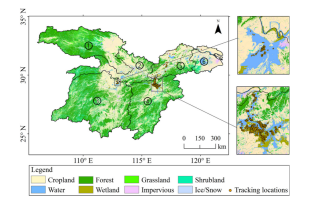The distribution of food resources is a key factor in habitat selection. Herbivorous waterfowl prefer early-stage growing plants (from the onset of plant growth to the peak in nutrient biomass) as these offer higher energy intake rates. This plant development stage is not fully captured by commonly used satellite-derived vegetation indicators, which focus on plant biomass (e.g., Enhanced Vegetation Index, EVI) or active plant growth (e.g., the differential EVI between current and a previous date, diffEVI). To improve mapping suitable grazing areas for herbivorous waterfowl, we propose a new satellite-based plant growth indicator of early-stage plant growth (ESPG). We hypothesize that herbivorous waterfowl prefer plants at an early development stage during the growing season and select plants with a relatively later end of ESPG during the non-growing season. We use satellite tracking data of 20 greater white-fronted geese (Anser albifrons) wintering in the Yangtze River floodplain to validate our predictions. We build generalized linear models for goose distributions during the growing and non-growing seasons and compare the performance of ESPG to commonly used plant growth indictors (EVI and diffEVI). During the growing season, ESPG can explain 53% of variation in the goose distribution, outperforming EVI (27%) and diffEVI (34%). During the non-growing season, only the end of ESPG significantly influences goose distribution, explaining 25% of the variance (ESPG: AUC = 0.78; EVI: AUC = 0.58; diffEVI: AUC = 0.58). The newly-developed plant growth indicator ESPG could be used to improve models of herbivorous waterfowl distributions and hence support efforts toward waterfowl conservation and wetland management.

